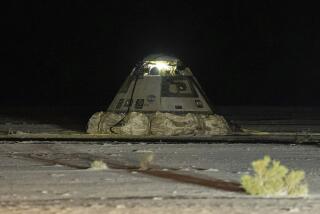Satellite Failure, Plumbing Breakdowns Plague Shuttle Crew on First Day in Orbit
KENNEDY SPACE CENTER, Fla. — The space shuttle Challenger, with seven astronauts sharing space with two monkeys, two dozen rats and a billion-dollar scientific payload, thundered into orbit Monday and immediately encountered a series of problems.
The crew failed in their attempt to release one of two tiny satellites from the shuttle’s cargo bay and will have to bring it back with them when they return to Earth next Monday. One of the three hydraulic generators that control wing flaps, landing gears and rocket nozzles overheated, and NASA ground control officers ordered the generator shut down.
There were plumbing breakdowns as well. An analysis device, newly added to the shuttle toilet, sprayed urine into the cabin. Later, the drinking water faucet in the galley quit. Both problems were eventually solved: The analysis device was turned off, and the crew hooked a hose into a backup drinking water outlet.
Mishap Delays Launch
Other problems included false readings on instruments and wrong computer readouts. The launch itself was also delayed two minutes to 9:02 PDT because of a malfunction in the flow of liquid oxygen to the shuttle. Ground crewmen immediately went to a backup system.
None of the problems threatened the mission, and the crew’s enthusiasm appeared undampened. “A consensus up here is that it was a great ride, and we highly recommend it,” said flight commander Robert F. Overmyer after the hydraulic problem was solved.
But the glitches on this 17th shuttle mission were of some concern because they could reflect on the quick turnaround time of the shuttle launch schedule. Challenger, making its seventh spaceflight --a record--blasted off just 17 days after Discovery took off from the same launch pad, representing a record turnaround and a test of a planned once-a-month flight schedule.
Challenger, carrying the $1-billion, European-built Spacelab into space for the second time, is to carry out 15 scientific experiments before the planned touchdown at Edwards Air Force Base in California next Monday. The landing location was changed from the Kennedy center to the broader desert landing site because of tire and brake problems when Discovery landed here on April 19.
One Satellite Launched
The Challenger crew did successfully launch one 115-pound satellite, despite the discovery of a defect in the satellites only days before liftoff. The small satellites were found to have defective batteries that would lose voltage over long periods in the cargo bay’s vacuum and extremely cold temperatures. National Aeronautics and Space Administration officials opted to cancel the deployments, even though the satellites could not be removed from the shuttle at such a late date.
But Overmyer interceded, and the launching of the satellites was moved up to five hours after liftoff, before the batteries--similar to ones used for garage door openers--would have time to lose power.
It was apparently Overmyer’s insistence that swayed space officials into going ahead with the deployment.
“It sure didn’t hurt,” said Leonard Arnowitz, chief of the special payloads divisions of Goddard Spaceflight Center.
The satellite that successfully ejected was built by students at Weber State University in Ogden, Utah, to measure antenna patterns for the Federal Aviation Administration. The second, a government satellite that was to monitor ground signals and command oceanographic signals, did not launch, but the lid on the canister holding the satellite did close, making it unnecessary to attempt a space walk to batten down the container before the shuttle returns to Earth.
Spacelab Experiments
Challenger was scheduled to cease all maneuvers this morning so that sensitive scientific experiments can be performed in the 23-foot-long Spacelab. The stability is essential for many of the experiments, which include the growth of crystals in a zero-gravity environment, fluid dynamics and work in what is called “container-less manufacturing.” In all three, any sudden motion could wreck the experiments.
With Overmyer on this flight are Frederick D. Gregory, his co-pilot, and crewmen Don Lind, Dr. Norman E. Thagard, Dr. William E. Thornton, Taylor Wang and Lodewijk van den Berg. Thornton, at 56, is the oldest man to fly in space. Lind, an astronaut since 1966, has waited 19 years for his first space mission.
The two monkeys and 24 rats, which will be monitored by Thornton, will be studied when they return to Earth to determine the effects of weightlessness on them. For the rats, weightlessness will be one of the last sensations they will feel. They will be killed as soon as they return to Earth and their organs will be measured to see how they have been affected by a zero-gravity environment. The monkeys will be kept alive.
More to Read
Sign up for Essential California
The most important California stories and recommendations in your inbox every morning.
You may occasionally receive promotional content from the Los Angeles Times.










